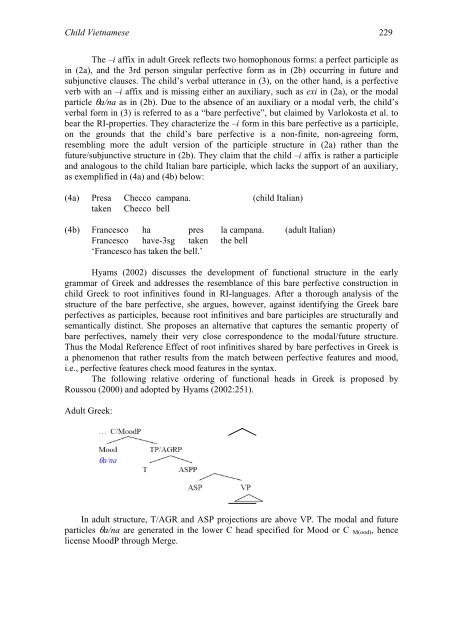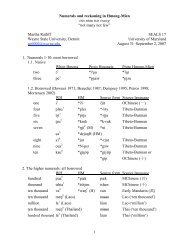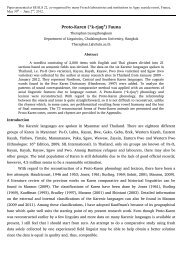proto-southwestern-tai revised: a new reconstruction - seals 22
proto-southwestern-tai revised: a new reconstruction - seals 22
proto-southwestern-tai revised: a new reconstruction - seals 22
Create successful ePaper yourself
Turn your PDF publications into a flip-book with our unique Google optimized e-Paper software.
Child Vietnamese <strong>22</strong>9<br />
The –i affix in adult Greek reflects two homophonous forms: a perfect participle as<br />
in (2a), and the 3rd person singular perfective form as in (2b) occurring in future and<br />
subjunctive clauses. The child’s verbal utterance in (3), on the other hand, is a perfective<br />
verb with an –i affix and is missing either an auxiliary, such as exi in (2a), or the modal<br />
particle �a/na as in (2b). Due to the absence of an auxiliary or a modal verb, the child’s<br />
verbal form in (3) is referred to as a “bare perfective”, but claimed by Varlokosta et al. to<br />
bear the RI-properties. They characterize the –i form in this bare perfective as a participle,<br />
on the grounds that the child’s bare perfective is a non-finite, non-agreeing form,<br />
resembling more the adult version of the participle structure in (2a) rather than the<br />
future/subjunctive structure in (2b). They claim that the child –i affix is rather a participle<br />
and analogous to the child Italian bare participle, which lacks the support of an auxiliary,<br />
as exemplified in (4a) and (4b) below:<br />
(4a) Presa Checco campana. (child Italian)<br />
taken Checco bell<br />
(4b) Francesco ha pres la campana. (adult Italian)<br />
Francesco have-3sg taken the bell<br />
‘Francesco has taken the bell.’<br />
Hyams (2002) discusses the development of functional structure in the early<br />
grammar of Greek and addresses the resemblance of this bare perfective construction in<br />
child Greek to root infinitives found in RI-languages. After a thorough analysis of the<br />
structure of the bare perfective, she argues, however, against identifying the Greek bare<br />
perfectives as participles, because root infinitives and bare participles are structurally and<br />
semantically distinct. She proposes an alternative that captures the semantic property of<br />
bare perfectives, namely their very close correspondence to the modal/future structure.<br />
Thus the Modal Reference Effect of root infinitives shared by bare perfectives in Greek is<br />
a phenomenon that rather results from the match between perfective features and mood,<br />
i.e., perfective features check mood features in the syntax.<br />
The following relative ordering of functional heads in Greek is proposed by<br />
Roussou (2000) and adopted by Hyams (2002:251).<br />
Adult Greek:<br />
In adult structure, T/AGR and ASP projections are above VP. The modal and future<br />
particles �a/na are generated in the lower C head specified for Mood or C M(ood), hence<br />
license MoodP through Merge.





